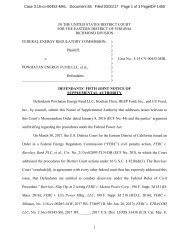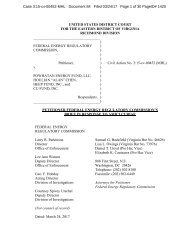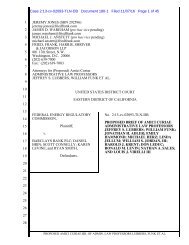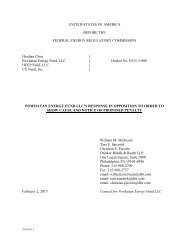Reply-ISO-Motion-for-Leave-to-File-Brief-as-Amici-Curiae
Reply-ISO-Motion-for-Leave-to-File-Brief-as-Amici-Curiae
Reply-ISO-Motion-for-Leave-to-File-Brief-as-Amici-Curiae
You also want an ePaper? Increase the reach of your titles
YUMPU automatically turns print PDFs into web optimized ePapers that Google loves.
C<strong>as</strong>e 3:15-cv-00452-MHL Document 77 <strong>File</strong>d 12/27/16 Page 7 of 13 PageID# 1181<br />
Neona<strong>to</strong>logy Assocs., P.A. v. Comm’r of Internal Revenue, 293 F.3d 128, 132 (3d Cir. 2002)<br />
(Ali<strong>to</strong>, J.) (explaining that, “[e]ven when a party is very well represented, an amicus may provide<br />
important <strong>as</strong>sistance <strong>to</strong> the court”); Canamar v. McMillin Tex. Mgmt. Servs., LLC, Civ. A.<br />
No. SA-08-CV-0516 FB, 2009 U.S. Dist. LEXIS 108986, at *3 (W.D. Tex. Nov. 20, 1999)<br />
(accepting amicus brief over opposition where “the in<strong>for</strong>mation supplied is potentially useful <strong>to</strong><br />
the Court and beyond that which the parties themselves have provided in their extensive<br />
briefing”). As then-Circuit Judge Ali<strong>to</strong> observed in Neona<strong>to</strong>logy Associates, “denying motions<br />
<strong>for</strong> leave <strong>to</strong> file an amicus brief whenever the party supported is adequately represented would in<br />
some instances deprive the court of valuable <strong>as</strong>sistance.” 293 F.3d at 132 (endorsing the view<br />
that “[s]ome amicus briefs collect background or factual references that merit judicial notice”<br />
and “[s]ome friends of the court are entities with particular expertise not possessed by any party<br />
<strong>to</strong> the c<strong>as</strong>e.” (quotation marks and citation omitted)). Here, amici, <strong>as</strong> experts in administrative<br />
law, bring <strong>to</strong> this Court a useful perspective and highly relevant background in<strong>for</strong>mation not<br />
previously addressed by the parties. This in<strong>for</strong>mation merits this Court’s attention, regardless of<br />
whether the parties in this c<strong>as</strong>e are well represented.<br />
FERC also complains that the proposed brief “does not provide useful legal analysis<br />
materially different from that contained in Respondents’ own briefing.” [ECF Dkt. No. 76] at 4<br />
(citing the discussion in the proposed brief of amicus Professor William Funk’s research). This<br />
complaint is plainly wrong. The one example of purported “duplication” cited by FERC is the<br />
discussion of Professor Funk’s research that had previously been discussed by the defendants in<br />
this c<strong>as</strong>e (see [ECF Dkt. No. 76] at 4), but the discussion in the proposed brief w<strong>as</strong> plainly part of<br />
a broader discussion of the his<strong>to</strong>rical background of the administrative <strong>as</strong>sessment of civil money<br />
penalties, <strong>as</strong> indicated by the heading title <strong>for</strong> that section of the brief. See [Dkt. No. 70-1] at 4<br />
7






